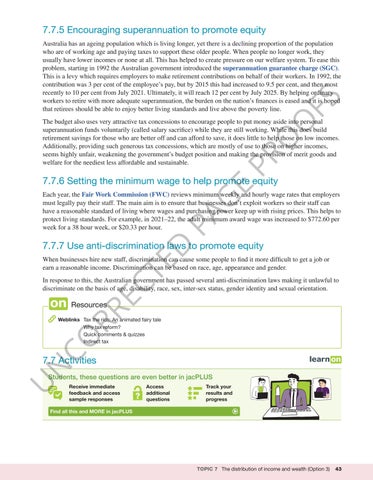“c07TheDistributionOfIncomeAndWealth_PrintPDF” — 2022/6/2 — 15:01 — page 43 — #43
7.7.5 Encouraging superannuation to promote equity
FS
Australia has an ageing population which is living longer, yet there is a declining proportion of the population who are of working age and paying taxes to support these older people. When people no longer work, they usually have lower incomes or none at all. This has helped to create pressure on our welfare system. To ease this problem, starting in 1992 the Australian government introduced the superannuation guarantee charge (SGC). This is a levy which requires employers to make retirement contributions on behalf of their workers. In 1992, the contribution was 3 per cent of the employee’s pay, but by 2015 this had increased to 9.5 per cent, and then most recently to 10 per cent from July 2021. Ultimately, it will reach 12 per cent by July 2025. By helping ordinary workers to retire with more adequate superannuation, the burden on the nation’s finances is eased and it is hoped that retirees should be able to enjoy better living standards and live above the poverty line.
PR
O
O
The budget also uses very attractive tax concessions to encourage people to put money aside into personal superannuation funds voluntarily (called salary sacrifice) while they are still working. While this does build retirement savings for those who are better off and can afford to save, it does little to help those on low incomes. Additionally, providing such generous tax concessions, which are mostly of use to those on higher incomes, seems highly unfair, weakening the government’s budget position and making the provision of merit goods and welfare for the neediest less affordable and sustainable.
E
7.7.6 Setting the minimum wage to help promote equity
PA
G
Each year, the Fair Work Commission (FWC) reviews minimum weekly and hourly wage rates that employers must legally pay their staff. The main aim is to ensure that businesses don’t exploit workers so their staff can have a reasonable standard of living where wages and purchasing power keep up with rising prices. This helps to protect living standards. For example, in 2021–22, the adult minimum award wage was increased to $772.60 per week for a 38 hour week, or $20.33 per hour.
D
7.7.7 Use anti-discrimination laws to promote equity
TE
When businesses hire new staff, discrimination can cause some people to find it more difficult to get a job or earn a reasonable income. Discrimination can be based on race, age, appearance and gender.
CO RR EC
In response to this, the Australian government has passed several anti-discrimination laws making it unlawful to discriminate on the basis of age, disability, race, sex, inter-sex status, gender identity and sexual orientation.
Resources
Resourceseses
Weblinks Tax the rich: An animated fairy tale Why tax reform? Quick comments & quizzes Indirect tax
N
7.7 Activities
U
Students, these questions are even better in jacPLUS Receive immediate feedback and access sample responses
Access additional questions
Track your results and progress
Find all this and MORE in jacPLUS
TOPIC 7 The distribution of income and wealth (Option 3)
43





















































